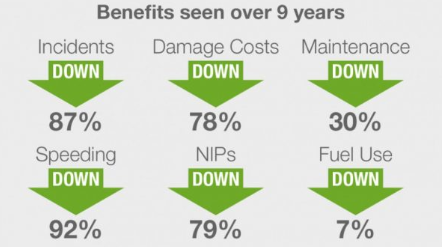In the world of driver and fleet safety, you will read many claims about the benefits of investing time and money to ensure that your company or organisation doesn’t form part of your local road casualty statistics.
The figure shown below are typical of the claims made by companies. But are they accurate and can they relate to your own experience?
Driving for Better Business (2020)
There is no doubt that there is a cost to investment in Driving for Work schemes, whatever methodology you choose, so in these challenging times, you need to ask yourself is it worth it?
Looking at the Driving for Better Business figures, it would be an obvious choice. Who wouldn’t want to save 78% in damage costs and 7% in fuel? But where do those figures come from?
In this case, it is from companies and organisations that have been through the process themselves. If you would like to read about their experience you can check them out here. There is a wide range of employers from supercar manufacturers, care agencies, logistics providers and construction companies, even a Fire & Rescue Service is featured.
Each of them has been on a journey, made mistakes and learned from them, but have ended up in a better place than they started. But there is the obvious question of ‘do I need to bother?’
If you put drivers and vehicles out on the road, yes you do. Just based on statistics, in the UK around every third crash involves someone who is at work. So it is likely to be the case of when not if one of your employees is one of them.
Apart from that, there are legal responsibilities to consider. If one of your team is travelling on the highway network, that is still considered to be the workplace, and Health & Safety regimes apply.
So, if you decide to deal with the issue, how will you know it works? As part of the process, we would advocate that you gather baseline data. Hopefully, this already exists within your organisation.
There will be obvious costs such as fuel, vehicle repairs, insurance premiums and vehicle hire costs. Still, there are benefits to digging deeper than that.
Have you lost employee hours as a result of road traffic collisions? To find out, can you mark your sickness records to indicate that particular cause? This is starting to move into the world of hidden costs - the areas that result from loss of vehicles and drivers but maybe days or weeks afterwards.
Other examples would be re-shipping an interrupted delivery or rescheduling a meeting because a key person was not present. But even beyond that, have you considered employee and team morale, their sense of wellbeing, and how valued they feel? The way you deal with their road risk directly affects those less tangible elements.
But the bottom line is, how do you capture this information? Firstly, identify the data sets you need and establish the baseline. These include fuel, tyre replacement, damage repair, insurance costs, all the clear, obvious and tangible budget lines that already exist but may need to be grouped together.
From there, it would be ideal to know if the behaviours and performance of your employees improve as a result of any intervention you put into place; a new policy, driver handbook, driver workshop or e-learning module. Driver telematics is extremely helpful in this area. It doesn’t have to be the black box ‘spy in the cab’ approach, there are innovative reward-based apps that allow this information to be harvested, but you already know that because you are on this website.
The real bottom line is, are your colleagues out on the road getting it right?
I have seen many fabulous Driving for Work policies that are worthless because they are not communicated across the organisation, and employees (at all levels) are not bought into the concept. Make it an inclusive process and check that it has landed well!
From there you can delve even deeper. Don’t just stop at the financial information; are your colleagues inspired and motivated to do the right thing when driving your or their own vehicles? Do they feel a sense of pride in representing your brand out on the road? Do they feel that their employer cares about their wellbeing and the safety of those around them?
Maybe an annual attitudinal survey would shine some light on these questions, that information would certainly support other data gleaned from telematics and costs.
So, to answer the original question, I absolutely believe that it is worth investing in your vehicle use regime. However, that investment will be intangible and of little value, if it is not supported with evidence, data and regular review.
There are numerous technologies, systems and supports out there to help you through the process. Pick the ones that suit you best and take the next step forward!






